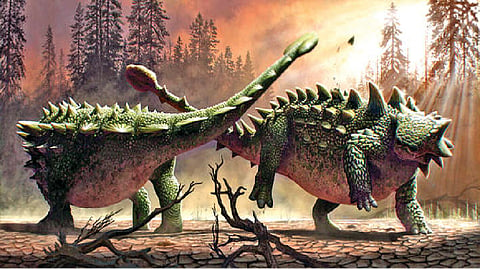

To ward off super-sized predators, many herbivorous dinosaurs were biologically armed to the teeth. Some had skulls studded with horns, while others had tails bristling with spikes. But few matched the arsenal of ankylosaurs, a group of herbivores that peaked in diversity during the Cretaceous period. Most of the ankylosaur’s body was encased in bony plates that jutted out into jagged points, and some lugged around a sledgehammer-like tail club capable of delivering a bone-cracking blow. Because of their seemingly indestructible nature, paleoartists and researchers alike have spent decades hypothetically pitting these plant-powered tanks against tyrannosaurs and other apex carnivores. However, predators may not have been the only creatures absorbing their batterings.
In a study published Wednesday in the Biology Letters, researchers analysed the anatomy of one of the world’s most complete ankylosaur skeletons. They discovered several broken and healed armour plates concentrated around the creature’s hips that lacked any clear signs of disease or predation. Instead, the armour appeared to have been splintered by another ankylosaur’s club.
“The injuries are right where you’d expect two battling ankylosaurs would break things,” said Victoria Arbour, a paleontologist at the Royal BC Museum in British Columbia and an author of the study.
The exquisitely preserved ankylosaur skeleton, which sports a full suit of armour plates called osteoderms, was accidentally unearthed in 2014 by commercial fossil hunters excavating a nearby tyrannosaur in Montana’s Judith River Formation. When the Royal Ontario Museum in Toronto acquired it, the bulk of the creature’s skeleton was still entombed in a 35,000-pound slab of sandstone, leaving just its skull and tail free.
Based on the ankylosaur’s skull and its club at the end of a thorny tail, it was clear the animal was a unique species. The dinosaur’s horn-encrusted head reminded Dr. Arbour, then a postdoctoral researcher at the Ontario museum, of the gnarly mug of Zuul, the terror dog from the film “Ghostbusters.” In 2017, she and her colleague christened the new species Zuul crurivastator, or “Zuul, the destroyer of shins.”
The rest of Zuul’s body remained trapped in the stone for more than a year as fossil preparators painstakingly chipped away at the rock. They eventually uncovered fossilised skin dotted with osteoderms. As they worked their way toward Zuul’s backside, they discovered that some spikes along the animal’s hips were missing their tips and that the bony sheaths encasing these osteoderms had broken and healed into blunt points.
Because the damaged plates were clustered around Zuul’s hips, Dr. Arbour and her colleagues began to question whether they were defensive scars from a failed attack. Bipedal hunters like Gorgosaurus, a lanky cousin of the Tyrannosaurus rex, would have attacked Zuul from above instead of smashing into its flank. And few spots were as unappetising as Zuul’s spike-covered haunches, which were within striking distance of its club.
Visit news.dtnext.in to explore our interactive epaper!
Download the DT Next app for more exciting features!
Click here for iOS
Click here for Android